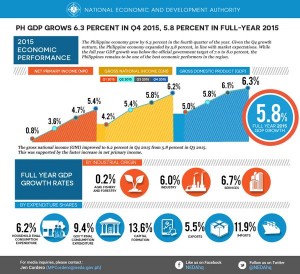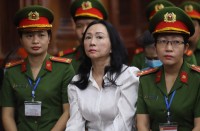
(Eagle News) — The Philippine economy grew 5.8 percent in 2015, which was below the earlier government growth target of 7-8 percent.
“The acceleration of growth from the first quarter to fourth quarter has been very encouraging, bringing the average full-year growth to 5.8 percent. Though this is lower than what we targeted for the year, this growth is respectable given the difficult external environment, the onset of El Nino, and the challenges in government spending in the first semester,” Economic Planning Secretary Arsenio Balisacan said on Thursday.
Still, Malacanang and the National Economic and Development Authority (NEDA), trumpeted the triumph of the NEDA report showing a 6.3 percent increase in the country’s Gross Domestic Product for the fourth quarter of 2015.
“This morning, the National Economic and Development Authority announced that the country’s real GDP growth for the fourth quarter of 2015 accelerated to 6.3 percent, up from 6.1 percent last quarter. This is the highest quarterly growth rate for the year, and brings our full-year GDP to 5.8 percent,” Presidential Spokesperson Edwin Lacierda said in a statement on Thursday.
The Palace official said that according to the report, increased momentum during the second semester was supported by strong domestic demand—with government final consumption growing faster by 17.4 percent—as well as robust growth in the industry and services sectors, which posted growth rates of 6.8 percent and 7.4 percent, respectively. On the demand side, the report also noted the increasing role of investments in economic growth, with fixed capital contributing 4.9 percentage points to the fourth quarter GDP.
“With these latest figures, the six-year moving average of real GDP growth has now reached 6.2 percent—the highest in 38 years, since 1978,” Secretary Lacierda said.
Balisacan said that this “consistent growth … has not been seen in the past four decades and, two, the growth has not been due to unsustainable borrowing as in the 1970s nor by short-lived portfolio capital. Rather, we see investments in areas that create jobs, increase incomes, and improve people’s wellbeing.”
He said that the 2015 growth was driven by a much stronger domestic demand.
Government spending accelerated to 9.4 percent compared to last year’s 1.7 percent. Growth in public and private investments also more than doubled to 13.6 percent from last year’s 5.4 percent.
NEDA noted that this was primarily led by public construction, which grew by 20.6 percent from 6.3 percent in 2014. As these investments get translated into increased employment and incomes, and with record-low inflation, household consumption also grew by 6.2 percent.
But NEDA noted that growth in exports had been lackluster at 5.5 percent compared to last year’s 11.3 percent.
Exports in services, however, have been very strong given the BPO sector’s robust performance. There is still a lot of room for expansion in the BPO sector towards higher value-added services—and this will require a more diversified set of skills and services and can stimulate economic activities in more sectors, NEDA said.
On the supply side, growth remained driven by the services sector, where growth accelerated to 6.7 percent in 2015 from 5.9 percent in 2014. This is followed by industry which grew by 6.0 percent. Agriculture, on the other hand, remains a challenge with its 0.2 percent growth, Balisacan said.
“With sound fundamentals and ongoing structural changes in the economy that make it more resilient to shocks, we can expect higher growth for 2016 as the global economy also picks up,” he said.
The former NEDA chief also detailed the remaining challenges that the next administration will continue to confront, given the serious threats from climate change and the realities of a global economy, we cannot afford to be complacent.
“The biggest lesson we have learned over the past six years is that we need to build resiliency in each sector of the economy and the socioeconomic resiliency of each individual and community. Each sector has to be diversified in terms of products and markets:
- The agriculture sector, in particular, is vulnerable to weather shocks which, of late, has been more frequent and rather extreme (from El Nino to Yolanda, floods, etc.).
- The industry sector, on the other hand, is much affected by external demand, which has been weak in all of the past six years. For both sectors, innovation and diversification are the critical strategies.
- The services sector, on the other hand, has demonstrated that it can reach greater heights as more opportunities open for trade in services. We need to ensure that the policy environment is one that allows easier entry for firms and encourages innovation.”







